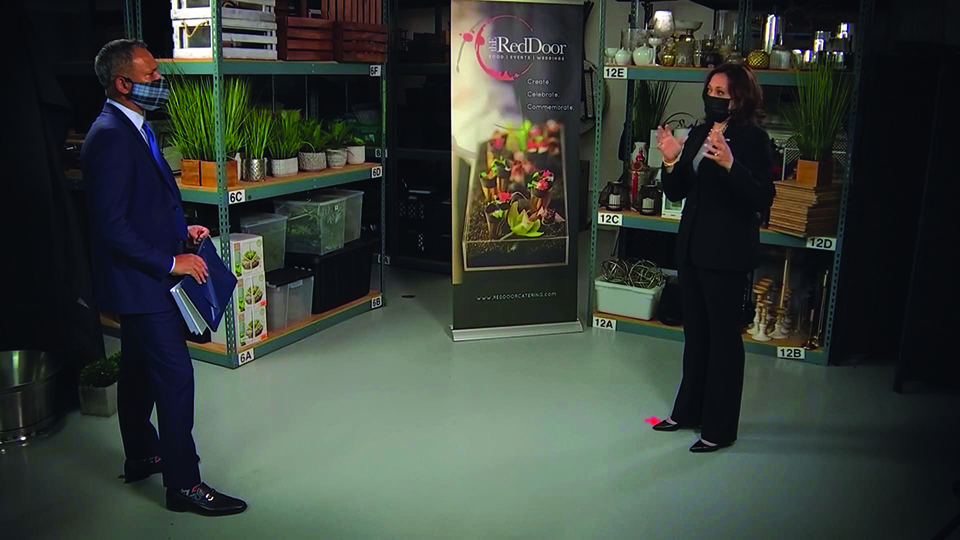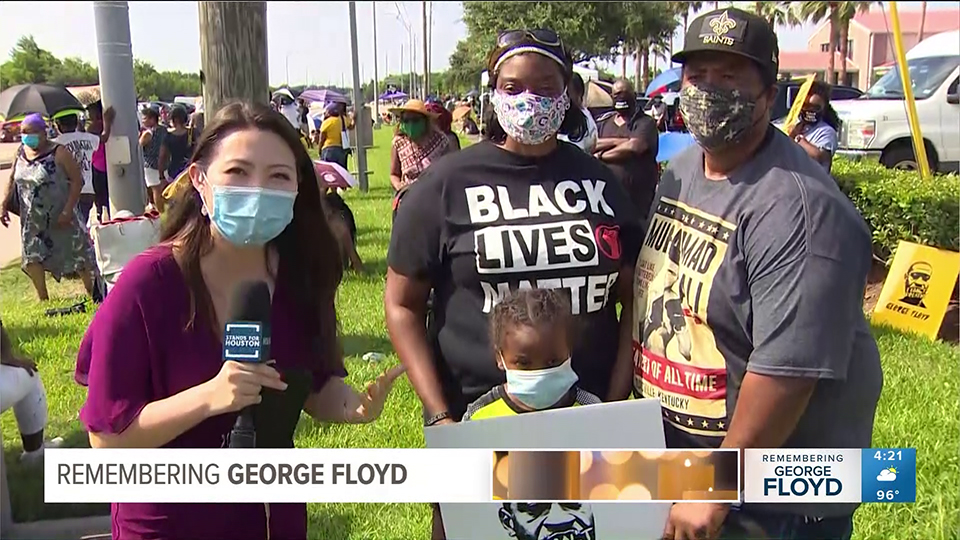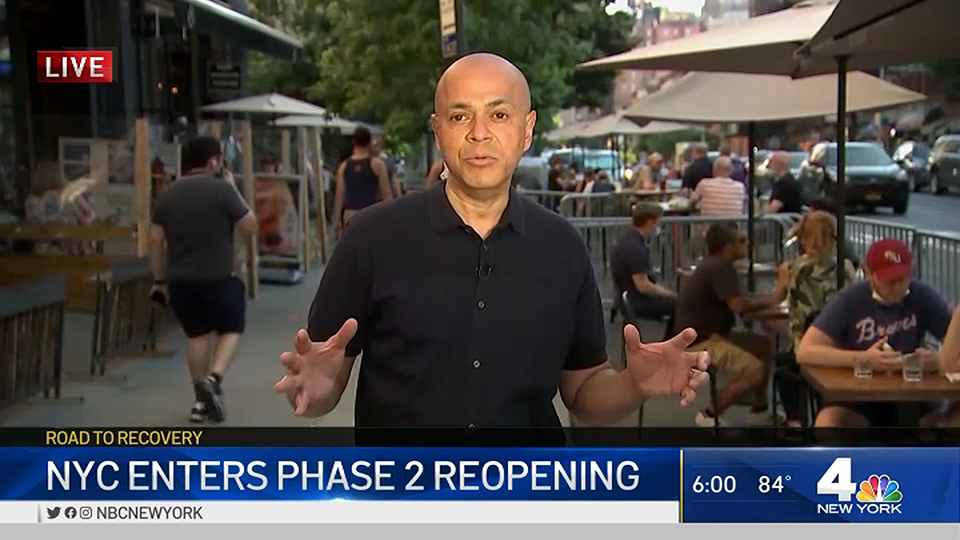Local TV Connects Amid Crises
Multiple stories of a lifetime arrived in a short period of time, and all had critical local angles that viewers wanted — and needed

Few would quibble that it is the age of streaming. Ratings across broadcast primetime are ailing, while series on the streamers, whether it was Tiger King on Netflix in the early days of the pandemic, The Mandalorian on Disney Plus more recently or another hit on another streamer, are commanding the eyeballs and buzz.
But a funny thing happened when the massive news stories of the past year-plus, including the pandemic, the racial reckoning following George Floyd’s death and a monumental presidential election, dropped on America. Lots and lots of viewers turned to their trusted local stations for perspective on the major issues. The hot streamers may have dazzling entertainment fare, but what they didn’t have was the latest news on COVID-19 in Columbus, or protests in Portland.
“What’s missing from all those services is local news and information,” Bill Hague, executive VP at consulting firm Magid, said. “The void on the streamers is local news and information. People still want to know what the weather is going to be, and the latest on COVID.”
A Pew Research Center survey from April 2020 revealed the level of trust viewers have in their local TV outlets. Asked which source gets the facts right about COVID-19 “almost all or most of the time,” 50% of the respondents said “your local news media,” higher than “news media in general” at 44% and then-President Donald Trump and his administration (30%).
Pew also reported that 23% of respondents tuned in more to state and local news on the pandemic, while 15% follow network news more.

When the virus became a big news story early in 2020, local TV viewing skyrocketed. That so many people were stuck at home, and free to watch the noon news, the 4 p.m. telecast, the early evening programs, and live updates at various times of the day, boosted ratings dramatically. “The pandemic really underlined the value of local news,” said Stacy Owen, president and general manager of KNTV-KSTS in the San Francisco Bay Area. “When it comes to a story like that, people want to know, what about my county, my city, my neighborhood? How is the virus tracking in my county? That’s the kind of information you only get from local news.”
At 6 p.m. in Cleveland, in May 2020, WKYC averaged a 5.5 share in viewers 25-54, up 20% from the 4.6 it did in May 2019. From March to May 2020, WNBC New York saw “some of the highest ratings since 2007” in early-evening news, according to Eric Lerner, president and general manager.
Broadcasting & Cable Newsletter
The smarter way to stay on top of broadcasting and cable industry. Sign up below
WNJU New York president/GM Cristina Schwarz said viewers of the Telemundo station wanted translated updates on COVID-19 from civic officials in real time. “The connection was almost immediate, this desperation about, ‘What do I do, where do I go?’ ” she said. “There was an immediate need for information, a fear of the unknown, a desperate need for information.”
Following the COVID-19 outbreak was Floyd’s death at the hands of Derek Chauvin in Minneapolis in May and the ensuing protests around the country, then the November presidential election and the Jan. 6 siege on the Capitol. “Any one of those would’ve been the story of a lifetime, and they all happened in less than 12 months,” WKYC president and GM Micki Byrnes said. “These were huge national stories, but they were also local because they affected everybody.”
Nonstop News
News networks of course see viewership spikes when giant news stories happen, and stations are no different. “This is when local newsgathering sources rise to the occasion,” Hague said. “Whether it’s Sept. 11 or a hurricane or a flood, that is when local stations become indispensable.”
Station newsrooms were energized by the blockbuster news events, and by viewers’ demand for a station’s take on them. “Internally, we felt like we had reignited our purpose,” Byrnes said. “We could literally save lives. We could improve lives. We could cut through the chaos overload of information and give people verified facts.”
Bobby Springer, president and GM of KHOU Houston, mentioned the news shifting from want-to-know to need-to-know for viewers across the past year-plus. “People returned to local media in a way that maybe they hadn’t done for a while,” he said. “Local journalists stepped up to the challenge.”
When it comes to a story like [the pandemic], people want to know, what about my county, my city, my neighborhood?
Stacy Owen, president and GM, KNTV-KSTS
Byrnes described the WKYC newsroom as “re-energized” amidst the burst of global stories with local implications. “It sounds crazy,” she said, “but this is what we were born to do.”
Station-level fact-checking platforms, such as Tegna’s Verify and Hearst Television’s Get the Facts, proved essential for viewers in the era of misinformation. Verify was launched in 2015. Viewers submit questions, and the Verify team clarifies and verifies the query. In 2020, Verify traffic on Tegna sites increased more than 400%, prompting Tegna to launch a national standalone Verify brand in May, in addition to the local versions.
“I can’t think of a better tool to be at your disposal,” Springer said. “This is what you’re hearing in your world, and here are four or five experts, and this is what they said. The simplicity of it, the transparency of it, it helped build trust early on.”
News in Normal Times
The challenge for stations is sustaining the ratings, and viewer interest, as the times become — knock on wood — more normal. Sampling of local content was sky high, and stations now hope they can keep the connection strong, especially with summer here, and ratings taking their usual dip.
Stations are wholly focused on strengthening their digital offerings to better connect with the next generation of news viewers, as the Netflix generation may not age into local newscasts the way their parents did. “Many young people came to TV in the early days of the crisis,” Barbara Maushard, senior VP of news at Hearst TV, said. “If they get it from an app or a website, that’s great, as long as they get the critical information.”
At the station level, Glenn Haygood, WLKY Louisville president and GM, said younger users were consistently offering feedback on content related to the social-justice movement that was major news in the city, where the March 2020 police-involved shooting of Breonna Taylor led to weeks of protests. “The notion that the younger segment of the population is not getting information from local broadcasters is just not true,” he said. “Everyone certainly knew where to go.”
Stations have done a better job of monetizing digital traffic, making it a legitimate revenue stream, and not just something there to promote the TV product. “We’re interested in being on any platform that reaches folks,” Lerner said. “OTT, Peacock, any digital platform, audio only — we don’t care what platform it is. If there are eyeballs and listeners and viewers, we will be there.”

With that in mind, WNBC premiered a 10-minute weekday digital newscast in April, available on the station’s Roku and Apple TV channels, and through the station app.
Stations are taking lessons learned during COVID and applying them to news product today. Lerner said WNBC viewers liked watching anchors delivering the news from home, feeling it made for a more genuine relationship between them and the station. “They weren’t fancy sets and the lighting wasn’t perfect — we just had a camera and a little backdrop,” he said.
As a result, NBC 4 anchors rarely sit behind desks these days. “We came to the conclusion that the desk is a barrier between us and our viewers,” Lerner said. “Now they’re in front of the desk, they’re standing, they’re moving. It’s something new that has improved our newscasts.”
Maushard said Hearst TV anchors broadcasting from a spare bedroom made for an at times more authentic presentation. Viewers were stuck at home, and reporters were as well. “We were a part of what’s happening, too,” she said.
Local News Boom
Stations have been expanding news at a feverish pace since the torrid news cycle began in early 2020. Stations averaged 6.2 hours of news per weekday in 2020, reported the Radio Television Digital News Association (RTDNA), up 18 minutes from 2019. (Stations decreased news output on weekends last year.)
WAPT Jackson, Mississippi, introduced 9 p.m. news on its MeTV diginet in August. The CW outlet KNVA Austin, Texas, tacked on a 7-9 a.m. news in September. WNBC debuted 7 p.m. news in June.
The 3 p.m. slot has emerged as a popular news destination with many people working remotely. WOIO Cleveland, KGO San Francisco and KRON San Francisco all have premiered 3 p.m. news, and WXIX Cincinnati does so in the fall.
The content expansions go beyond news. WKYC has monthly special The Turning Point, dedicated to racial equality, and weekly public affairs program We the People. WATN Memphis had town halls titled “Uncomfortable Conversations” about racial relations and “Candid Conversations” about the COVID vaccine.

Newsroom chiefs speak of a more nimble approach to news garnered during lockdown times, with news-gathering workarounds learned on digital platforms such as Zoom becoming part of everyday life in more normal times. Nearly 35% of stations reported an increase in local news in 2020, RTDNA reported, 7% more than in 2019, despite just 16% reporting a budget increase and 29% reporting a budget cut.
The racial reckoning in particular has prompted stations to rethink how they connect with the Black community in their markets. ABC’s owned stations have an 11-person race and culture team, with one journalist on that beat at each station. That team worked on the Juneteenth special Our America: Black Freedom, which aired on the stations, Localish and Hulu last month.
The notion that the younger segment of the population is not getting information from local broadcasters is just not true.
— Glenn Haygood, president and GM, WLKY
Springer, general manager of Tegna’s KHOU Houston, said station journalists are increasingly asked to share their experiences in the minority neighborhoods, which turn into lessons for the entire newsroom. “We started having better conversations inside our organization that resulted in a better knowledge and better sense of empathy,” he said.
Glenn Haygood is behind WLKY Louisville’s Marketing Awards Program, launched earlier this year and designed to help Black-owned businesses in Louisville. Nearly 100 businesses applied for the program and 10 were selected, the winners getting $100,000 grants. “The time was right for us to do something big and bold,” said Haygood. “There are so many ripple benefits we’re starting to see.”
Built for the Long Term
Initiatives such as WLKY’s marketing awards, station food banks and phone banks, and news content and specials, all make a compelling case as to why local broadcast should remain essential to viewers’ diets. The wild events of the past year-plus reminded viewers of the role strong stations play in their lives, and newsgatherers of their often critical job in a given market.
It was no great surprise that WKYC Cleveland improved its 6 p.m. news share 20% from May 2019 to May 2020. Perhaps more surprising is the station seeing an additional 11% gain at 6 p.m. from May 2020 to May 2021. WKYC’s 6 a.m. share, meanwhile, is up a staggering 40% from May 2020.
“All these challenges happened in a very short period of time, and local media stepped up in a way they hadn’t done before,” WKYC’s Byrnes said. “They had to. We had to. Because of that, I think we strengthened our connection to our communities.”
Michael Malone is content director at B+C and Multichannel News. He joined B+C in 2005 and has covered network programming, including entertainment, news and sports on broadcast, cable and streaming; and local broadcast television, including writing the "Local News Close-Up" market profiles. He also hosted the podcasts "Busted Pilot" and "Series Business." His journalism has also appeared in The New York Times, The L.A. Times, The Boston Globe and New York magazine.

